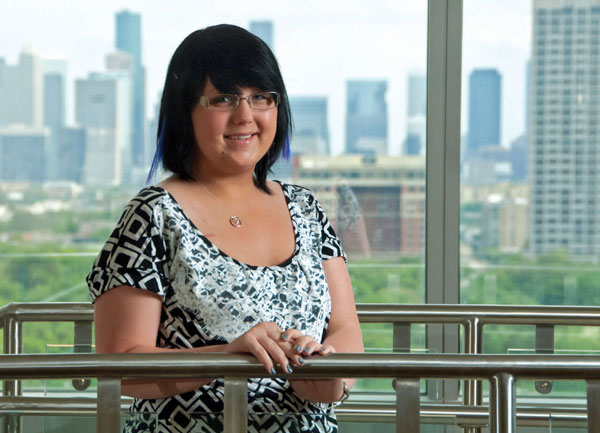形态蛋白质组学
As she was preparing to leave for a semester abroad in Europe, 20-year-old Baylor University student Bridgette Marshall heard news she never expected to hear. Her otorhinolaryngologist Martin J. Citardi, MD, FACS, told her she had a very rare and advanced form of cancer. “Sinonasal undifferentiated carcinoma is what they called it,” Marshall says. “If they hadn’t found it when they did, I would have been alive only a few more weeks.” She canceled her trip to The Netherlands, and put school and her life on hold.
Marshall’s CT and MR scans showed a very large mass that filled her entire nasal cavity and most of her paranasal sinuses with erosion into both orbits. In addition, the mass had a large intracranial extension with brain swelling and brain shift.
“我们带她去或活检,”马丁说。Citardi, MD, FACS, who is professor and chair of the Department of Otorhinolaryngology-Head and Neck Surgery at McGovern Medical School and chief of otorhinolaryngology at Memorial Hermann-Texas Medical Center (MH-TMC). “When the pathology report came back with a diagnosis of sinonasal undifferentiated carcinoma (SNUC), we knew right away that we wanted morphoproteomics. SNUC is an aggressive cancer, and the prognosis is poor. We wanted to bring everything we had to the table.”

Bridgette Marshall
The traditional treatment for SNUC based on 30 years of medical literature is radical open surgery, chemotherapy and radiation therapy. Dr Citardi and his colleagues “are always looking for a less invasive approach. From a surgical standpoint, he has shifted his rhinology practice for tumors to a less aggressive endoscopic approach that disassembles the inside of the nose to remove the tumor,” says pathologist Robert Brown, MD, who holds the Harvey S. Rosenberg, MD Chair in Pathology and Laboratory Medicine at the McGovern Medical School. “But he’s looking for more than just removal of the tumor, because that may not provide a cure. He wants to understand the chemistry of what makes tumor cells grow and spread, and combine his techniques with what we’re doing in proteomics to target the tumor with very specific, personalized anticancer treatment.”
Dr. Brown’s Consultative Proteomics Service at the McGovern Medical School is based on a type of protein study called morphoproteomics, which involves a visual inspection of the proteins in malignant cells. Using a fluorescence microscope, he looks for changes in the cellular location and state of activation of the proteins, which can help the patient’s oncologist identify the most vulnerable parts of cancer cells.
他说:“我们正在努力超越癌症。”“我在高中生物学课上学到的病理学的第一个原则是生物学变异。没有两个人都一样,也不喜欢父母。该原则适用于所有类型的癌症。该疾病总是有一种变异,在某些方面是患者独有的。作为病理学家,我们现在拥有定义单个肿瘤的生物学的工具,以便我们更好地了解驱动它的东西以及如何以对患者定制的方式中断途径。形态蛋白质组学没有将患者分为类别并根据标准方案进行治疗,而是将其视为个体。我们可以确定哪种疗法最能针对肿瘤的途径,并与我们的临床同事合作创建新颖的治疗方法。”
形态蛋白质组学requires the team efforts of pathology, medical oncology, surgical oncology and radiation oncology. “We discuss cases at our head-and-neck tumor board at least once a month,” Dr. Brown says. “We share our ideas one with the other and come up with a rational therapy based on an intellectual exchange of different viewpoints.”
当肿瘤委员会审查了布里奇特·马歇尔(Bridgette Marshall)的病例时,共识是根据形态蛋白质组学选择化学疗法,添加标准的放射治疗过程,并在治疗完成后重复成像研究。
根据她的个人生物学,她获得了3个周期的顺铂,依托泊苷和阿霉素,这些周期是传统的细胞毒性剂,这是通过形态蛋白质组学产生的肿瘤特征选择的。此外,形态蛋白质组学的特征表明存在二甲双胍的活性(一种主要用于治疗2型糖尿病)和褪黑激素(调节昼夜节律节奏的激素)的生化途径。这些口服剂的添加仅基于形态蛋白质组学。与增强肿瘤控制的潜在益处相比,两种药物的长期口服给药的增量成本和风险被认为很小。
在使用传统化学治疗剂和放射治疗的主动治疗过程中,获得了连续MRI和PET扫描以监测对治疗的反应。早期,很明显,肿瘤正在随着治疗而迅速收缩。在治疗结束时,MRI和PET扫描都与完全反应一致,没有任何两项研究的肿瘤证据。
“We were all amazed!” Marshall says. “When I was first diagnosed, I was in denial and refused to believe that there was something so deadly inside of me. After my first long stay in the hospital for treatment, I started coming to terms with my disease and wanted to learn more. A little research showed me that patients diagnosed with SNUC have only a little over a 60 percent two-year survival rate. I was terrified. And then my tumor was gone after two treatments.”
Citardi博士还担心马歇尔的鼻窦腔中的残留肿瘤,他向马歇尔(Marshall)提出了“第二种外观”程序,马歇尔(Marshall)同意这种手术干预。在化疗结束后3个月完成的过程中,Citardi博士进行了正效的鼻窦手术,并注意评估残留肿瘤可能性最大的那些区域。幸运的是,两侧都没有看到肿瘤。几天之内,她开发了水状的鼻漏,这是呕吐发作后对CSF泄漏的可疑。然后,马歇尔因排水管的解决方案而被接纳为腰部排水管。在或确认由于先前手术而没有明显的颅底违规行为,重复内窥镜检查。一个月后,她用Leksell GammaKnife®进行了立体定向放射外科手术,以治疗大脑中剩余的囊性病变。
“这是可怕的,这是一个漫长的旅程,“she says. “Seven months, four week-long hospital stays, two overnight stays, 13 scans, four surgeries, 35 radiation treatments, four emergency room visits, five outpatient chemotherapy treatments, two lumbar drains, more than 30 prescriptions, one Gamma Knife surgery, countless trips to Houston and here I am. Just seeing the morning sun seems to be a blessing. My cancer experience has brought me faith, helped me decide what I want to do with my life, shown me how much I’m loved, given me a drive to succeed more than before, brought me closer to my family and friends, and made me want to give back to the community that helped me so much. I’m a survivor.”
The benefits go beyond having fought cancer and won. “We’re not bombarding patients with redundant therapies that are toxic,” Dr. Brown says. “Morphoproteomics prevents unnecessary therapies, and the treatments we use tend to be lower dose. That adds to quality of life during and following treatment. Chemotherapy is expensive. If we can avoid giving patients a drug that costs, say, $65,000 a year and substitute it with agents that cost less than $1,000 a year, we’ve achieved a lot.”
Dr. Citardi believes that morphoproteomics holds promise. “It may be the wave of the future. We’re using it at our institution, and we hope to incorporate the tailored approach based on individual biology for cancer patients going forward, which will provide an additional avenue of treatment for patients who would otherwise fail standard therapies.
他补充说:“在该位置,这些病变与潜在的病理一样至关重要。”“由于每个人基本上都是自定义构建,所以我们认为最好的方法是提出定制的治疗方法。如果我们还可以避免疗法携带毒性而没有巨大好处或限制使用的疗法,那就是一件非常好的事情。”
